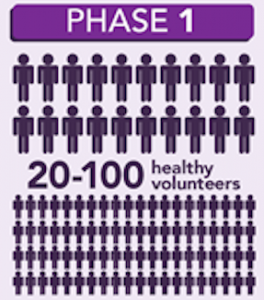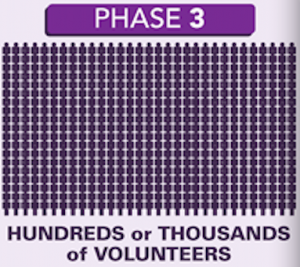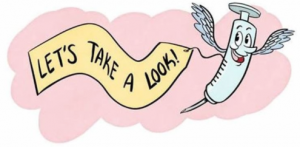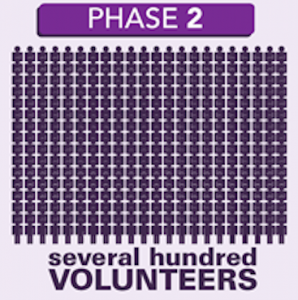How are vaccines made and released to the public?
- Live Attenuated Vaccines are made by weakening the natural virus or bacteria. MORE
- Inactivated Vaccines are created by killing the virus or bacteria with chemicals, heat, or radiation. MORE
- Subunit Vaccines are vaccines that use only part of the virus. MORE
- Toxoid Vaccines are vaccines that are made from the toxins from bacteria. MORE
- Conjugate Vaccines only use a small part of a bacterium linked to carrier protein. MORE
TWO ADDITIONAL TYPES OF VACCINES BEING RESEARCHED:
- DNA Vaccines involve using pieces of microbial DNA, which code for antigens–the pieces of the microbe that the immune system makes a response to–and injecting them into the body so that the body’s own cells can produce the antigens and make immune responses to them.
- Recombinant Vector Vaccines are similar to DNA vaccines, but they use an attenuated microbe to introduce microbial DNA to the body’s cells.
Once a vaccine has been created, it must go through several years of testing in the lab before it is ever given to people. This testing is paid for most often through government grants.
Once a vaccine is ready to be tested on humans, pharmaceutical companies fund the next three phases of studies, which typically cost millions of dollars. It may take several more years before a vaccine can be used by a general population.
These are the three phases of testing that a vaccine undergoes before it is even considered for licensure:
Phase I
 Fewer than 100 healthy human adults are enrolled in the study and given the vaccine. This phase focuses on the safety of the vaccine and whether or not there is an immune response to the vaccine. If the vaccine is found to be harmful or does not create antibodies to the virus or bacteria the vaccine is made for, then the vaccine does not move on to phase II.
Fewer than 100 healthy human adults are enrolled in the study and given the vaccine. This phase focuses on the safety of the vaccine and whether or not there is an immune response to the vaccine. If the vaccine is found to be harmful or does not create antibodies to the virus or bacteria the vaccine is made for, then the vaccine does not move on to phase II.
Questions looking to be answered: Is the vaccine safe? Does it seem to work? Are there any serious side effects? How is the size of the dose related to the side effects?
Phase II
A few hundred volunteers are enrolled in a phase II study if a vaccine passes the phase I study. These people are those who would ultimately be given the vaccine, if the vaccine makes it into use for the general population. The vaccine will not move on to phase III if it is found to be harmful or does not create antibodies to the virus or bacteria the vaccine is made for, just as in phase I.
Questions looking to be answered: How are the volunteers’ immune systems responding to the vaccine? What are the most common short-term side effects?
Phase III
These studies include thousands to tens of thousands of people in total, and these people are followed and studied for many years. Often times, several phase III trials will be preformed for one vaccine, looking at people across large geographic areas and those of different backgrounds and lifestyles.
Questions looking to be answered: How do people who get the vaccine and people who do not get the vaccine compare? What are the most common side effects? Is the vaccine safe? Is it effective?
Phase III studies determine whether vaccines work and if they are safe. If so, they are submitted to the U.S. Food and Drug Administration (FDA), where the results and validity of the three phase trials are evaluated.
After the vaccine has been evaluated by the FDA, it is considered to be safe for the use in humans, however it is still not ready for the public.
Next, it moves on to the scientists and doctors at the Centers for Disease Control and Prevention (CDC). A group called the Advisory Committee on Immunization Practices (ACIP) within the CDC, examines the research and makes recommendations on how the vaccine should be used and by what patients.
The final decision on who is safe to get the vaccine is made by the ACIP, the American Academy of Pediatrics (AAP), and the American Academy of Family Physicians (AAFP).
The vaccine is then licensed for use.
Phase IV (After licensure)
Even after the vaccine is licensed, research continues on the vaccine–called phase IV studies. The CDC is always monitoring the safety of the vaccine and gathering information on reported side effects.
There is a Vaccine Adverse Event Reporting System (VAERS) used to report significant negative side effects to a vaccine. Visit the VAERS website or contact VAERS directly to make reports: 1-800-822-7967.
There is also a system called the Vaccine Safety Datalink (VSD) that monitors vaccine safety and collects data across the USA from those who have received vaccinations. This site has vaccine information listed for a population of over 9 million people!
All vaccine information and research is reviewed carefully before a vaccine is ever recommended for children or put on the childhood vaccine schedule. Vaccine research continues for as long as the vaccine is available for use. Never ever do the health organizations stop collecting valuable information that pertains to the safety of the drugs that we put into our and our children’s bodies!
- The Children’s Hospital of Philadelphia (CHOP). www.chop.edu
- The Centers for Disease Control and Prevention (CDC). www.cdc.gov
- National Institute of Allergy and Infectious Disease. National Institutes of Health. www.niaid.nih.gov
- The history of Vaccines. The College of Physicians of Philadelphia. www.historyofvaccines.org
- Vaccine Healthcare Centers Network. www.vhcinfo.org
Photos courtesy of “Journey of Your Child’s Vaccine” info graphic from the CDC, as well as Vaccine Mom original art.



